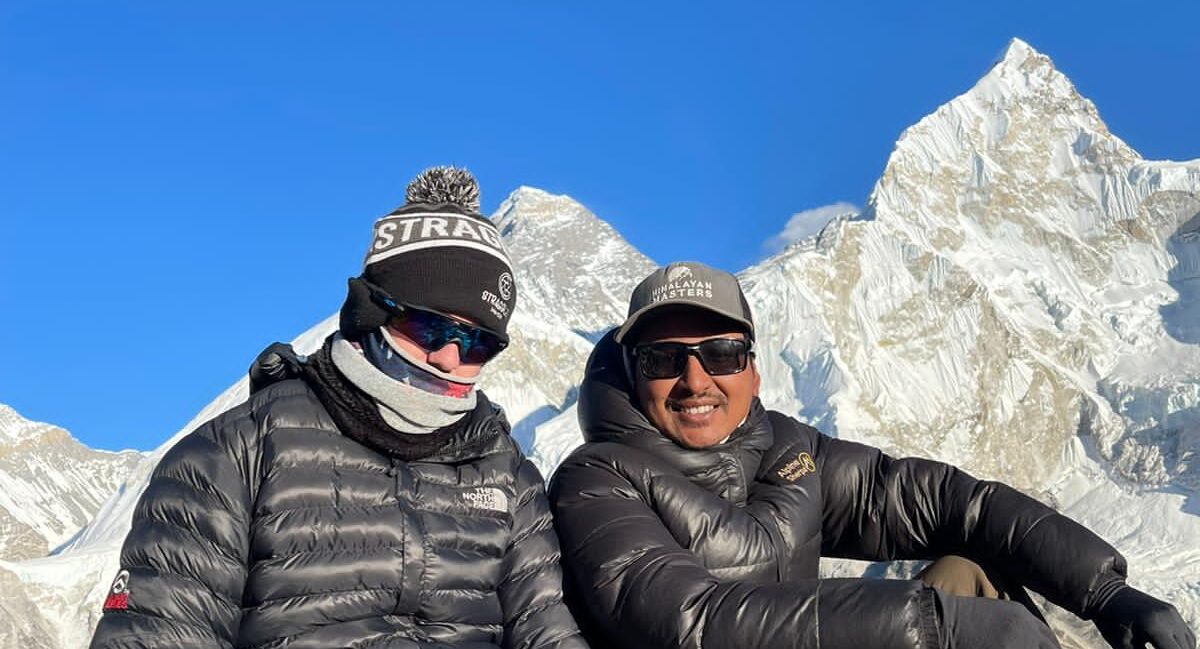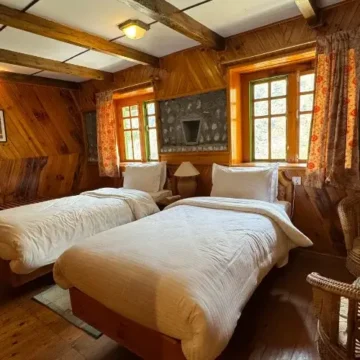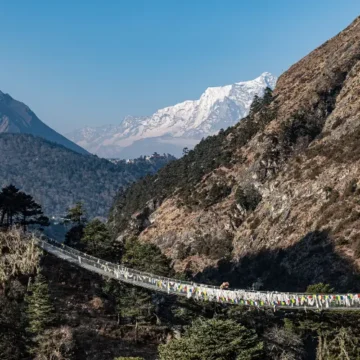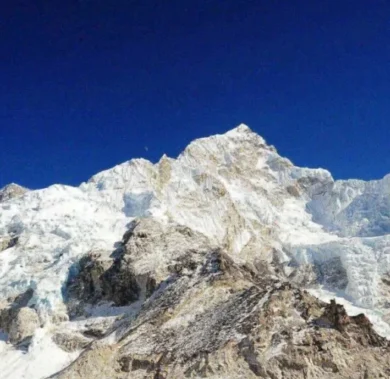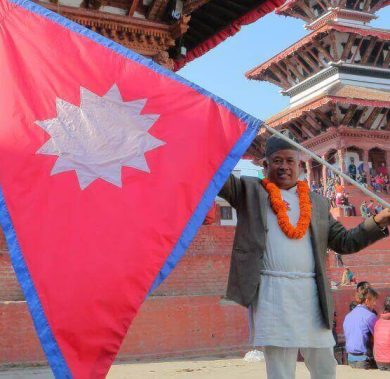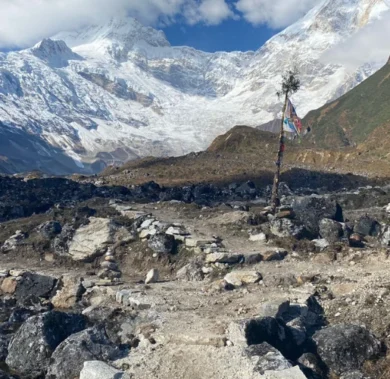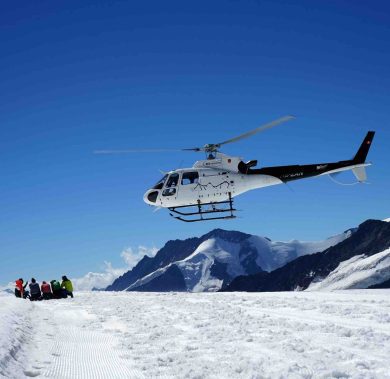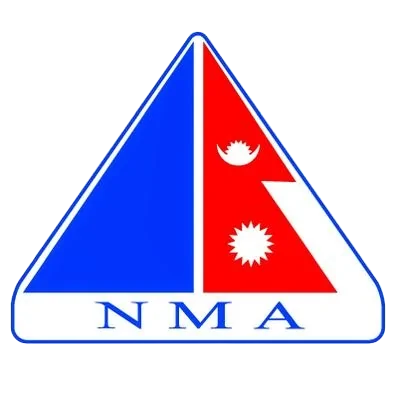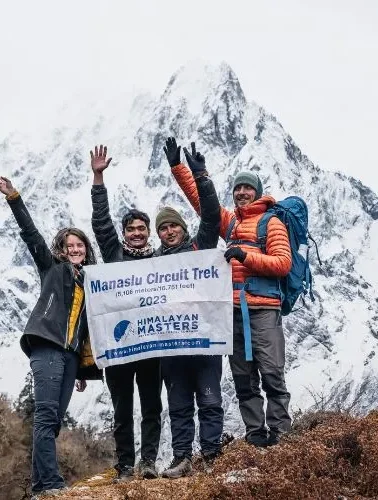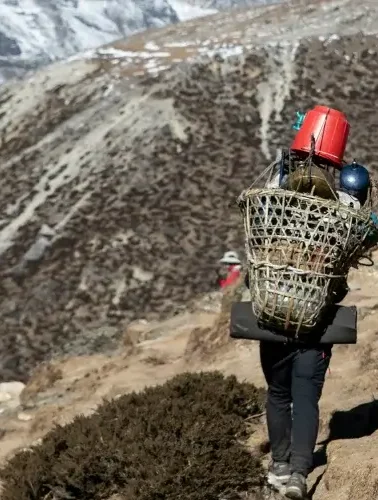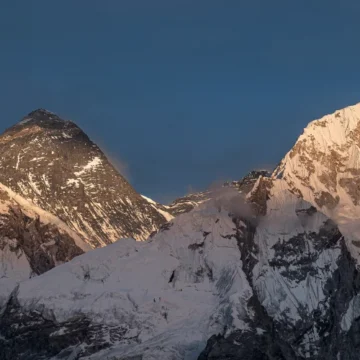
Everest Base Camp Trek Difficulty
Table of Contents
The most difficult routes in the world lead to the most beautiful destinations. And this stands true for the brave soul dreaming of a trek to the Everest Base Camp. Tourists often ask us, “Is Everest base camp difficulty that high?”. And the answer is “NO”. We have seen tourists underestimating Everest’s difficulty and returning within a few days of the trek.
We have also seen tourists thinking it’s impossible and fearing the journey even before it starts. And trust us, both these extremes aren’t true. Trekking in the rough mountain terrain of the Himalayas is challenging. However, it’s possible and deadly.
So, if you have ever dreamed of standing before the world’s tallest mountain and screaming “I love my life” out of your soul, read this article to the end, and you shall know how to make your dream come true. Everest base camp difficulty level is “Moderate”. It’s a non-technical, high-altitude trek for non-climbers.
How Long is The Everest Base Camp Trek?
Everest base camp trek is not something you plan for a day, so get started immediately. People plan it for months, even years, preparing themselves financially and physically. The Everest base camp trek from Kathmandu is about 10 to 15 days. Depending on your speed and health, it might take a shorter or longer time.
Experienced climbers go for a short Everest base camp trek, usually 9 to 10 days. However, we don’t recommend such a short Everest trek for newbies and less experienced trekkers. For people with average fitness and slow speed, Himalayan Masters have designed an Everest base camp trek Itinerary with 2 rest days in the mountains.
You can add a few more days to stay longer and experience the local culture. The longer you wait, the more complex your hike to Everest base camp difficulty will be. This explanation is only valid when you fly from Kathmandu to Lukla and start the trek. There’s another less preferred route that entirely skips the flight, and you will be trekking for the entire time.
For that, you should drive to Jiri (about 8 hrs ride from Kathmandu) and then trek from the village called Bhandara. On this route, you will stay in villages such as Sete, Jun Beshi, Nunthala, Bhuspa, and Surke before finally joining the Everest base camp via Jiri route at Phakding. This route adds six more days to your Everest base camp route.
How Hard Is It To Trek Everest Base Camp?
If you decide to walk back via the same route, it’s 4 to 5 more days. So, trekking to the Everest base camp from Jiri takes about 22 to 23 days. Even from Namche, there are many different routes for trekking to the Everest base camp. Some travellers prefer the off-beaten route of the Gokyo Lake Trek and the Everest three-pass trek before getting to the Everest base camp.
Adding these new destinations makes your trip 20 to 25 days long. Although the trek alone is 12 days long, your Nepal journey will be longer. Firstly, you must fly from your home country to Nepal and let your body recover from jet lag.
Give yourself 2-3 days for trek preparation, packing, and shopping. Also, a day or two to explore the beautiful city of Kathmandu is worth it. Adding all that, you can estimate the Everest base camp trek duration to be about 20 days long and arrange your time accordingly.
Tips to do a Succesful EBC Trek
Don’t rush. Since Everest base camp is a once-in-a-lifetime journey, ensure you savour everything Mother Nature offers. Take a month’s leave and visit different places in Nepal. Stay in Namche, Tengboche, and even Gorakshep for a few days. Hike other hills, interact with the locals and stay as long as possible. Even when you plan a month-long journey, each day of your Everest base camp trek will be enjoyable.
Everest Base Camp Trek Distance
The classic EBC route has the Everest base camp trek distance of about 130 km for the round trip to and from Lukla. 130 km in the mountain terrain is long, there will be about 15 km of daily walks. It’s not a big deal, considering an average human will walk 5 km/hour.
Distance-wise, Everest base camp difficulty is low. Walking 15 km daily would have been a piece of cake if the road was paved and levelled. However, hiking upwards and downwards in the sub-tropical forest for 15 km does make you tired.
Tips Before Everest Base Camp Trek
Start the trek quite early in the morning. Mornings are filled with great energy, and the weather is calm. Also, it will give you a long time for the trek, so you don’t have to rush in the evening. We recommend waking before 6 am daily and starting the hike at least 8 am. The earlier you start, the better. In the daytime, the sun makes it hard to walk.
Next, strolling is the key. The Everest base camp trek Itinerary by Himalayan Masters has about 5-6 hours of walking daily. However, you have an entire day to reach your destination. And even If you don’t get the place that has been recommended, you can find hotels on Everest throughout the route. So, don’t push yourself too hard. Breathe the fresh air, rest whenever you want, and stroll.
Altitude Gain during Everest Base Camp Trek
The trekkers needs to realize how dangerous altitude can be. Everest base camp altitude lies 5364 meters above sea level. Similarly, we hike up to Kala Patthar, a peak 5,500 meters tall. Here is the list of places on the Everest base camp trek and their altitude.
| Destination | Altitude in meters | Altitude in feets |
| Lukla | 2840 | 9317.6 |
| Phakding | 2610 | 8563 |
| Namche | 3440 | 11286 |
| Hotel Everest View | 3900 | 12795 |
| Tengboche | 3860 | 12664 |
| Dingboche | 4410 | 14468 |
| Nagarjuna Hill Top | 5100 | 16732 |
| Lobuche | 4910 | 16109 |
| Gorakshep | 5140 | 16863.5 |
| EBC | 5364 | 17598.5 |
| Kala Patthar | 5550 | 18209 |
As you can see, we will be walking beyond 4,000 meters on most days, and that’s when you start to feel the effect of the weather, a real Everest base camp difficulty. At this height, the oxygen level in the air falls to almost half, and the air pressure is also low. This can lead to the development of altitude sickness on Everest, which includes symptoms such as:
- Headache
- Feeling sick
- Dizziness
- Tiredness
- Loss of appetite
- Shortness of breath
- Fainting
In extreme cases, there might be symptoms of loss of coordination, hallucinations, tightness in the chest, cough, and the skin starting to get blue. Although this does sound scary, it’s a rear case, and you will be safe while travelling with the expert guides at Himalayan Masters.
Tips To Overcome From Altitude Sickness:
- Cover at most 1000 meters in a single day.
- Stop for rest after every 300 to 500 meters you climb during the trek
- Stroll and stop for rest whenever needed
- Include acclimatization day in your Itinerary (Namche and Dingboche are great places for acclimatization as per the Himalayan Masters Everest base camp trek Itinerary)
- Keep yourself hydrated with 3-4 litres of water (have lukewarm water if possible)
- Avoid smoking and all kinds of alcoholic drinks that make you dehydrated.
- Eat high-calorie food during the trek and keep your Immunity power boosted
What Should You Do When You Catch Altitude Sickness On Everest?
You should follow the given steps below if you catch altitude sickness in Everest Trek:
- Once you start feeling sick, stop the trek immediately and do not climb any further. You can walk down to the lower altitude and rest there for a few days if needed.
- Give bottled oxygen if required in emergency cases.
- Carry medicines such as acetazolamide to treat high-altitude sickness. You can have ibuprofen and paracetamol if you experience most kinds of headaches, and promethazine can be used for nausea.
- Even after all this preparation, the team arranges a helicopter rescue for you if things go outside control.
Weather And Climate During Everest Base Camp Trek
Another significant barrier to the Everest base camp’s difficulty is its weather and climate. Without a doubt, the Himalayas of Nepal are cold throughout the year. Everest base camp is covered in snow almost year-round. However, the entire Khumbu area is mostly warm and stable during Autumn and Spring.
Winter on Everest is very cold, and the region beyond Dingboche is always covered in thick snow. With the daytime temperature of about -5 to -3 degrees Celsius and the night temperature dropping to -15 degrees Celsius, it’s the most challenging month for the trek.
The summer trek in June and July is also challenging. The monsoon arriving from the Bay of Bengal makes the trail slippery. While the daytime is warm and you can trek with little clothes on, the leeches and mosquitos along the trail can increase Everest base camp difficulty.
Autumn and Spring have Everest base camp temperatures of 5 to 15 degrees Celsius, and the night is also above freezing point. The chances of snowfall and rainfall are also very low, making it the easiest time for the Everest base camp trek.
Tips To Avoid From Bad Weather
- As far as possible, aim for the Autumn and Spring trek only.
- While trekking in winter, carry trek boots that help you walk in the snow and crampons. Only travel solo with a guide in winter; a sleeping bag is compulsory. An expert for the winter trek must guide you.
- While trekking in summer, keep your itinerary flexible and travel only on non-rainy days. Also, make sure you have mosquito and leach repellents.
- Pack enough warm clothes, slippers, and waterproof bag cover/ trousers in all seasons.
The Remoteness and Services of Everest Base Camp Trek
If you have lived in luxury all your life, you cannot start to imagine how remote these mountain landscapes can be. During the trek, you will miss your warm bed, flushing washroom, and cell reception. These 12 days will be pretty sweaty, dirty, and stinky. Remoteness is a significant Everest base camp difficulty.
The Himalayas of Nepal have a challenging landscape, making it impossible to build physical infrastructure. There’s no roadway getting to the Everest region. The nearest airport is Lukla Airport, and a mule or porter carries everything beyond that. This means that even getting the basic facility is a blessing.
Thankfully, the Everest base camp trek is Nepal’s most popular and busiest trail for almost a century. So, everything needed for the comfortable stay of the tourist has been available. Even then, coping with such remoteness can be tough.
Accommodation:
Basic tea house accommodation is available on the Everest base camp route. Hotels in Namche are pretty luxurious. Otherwise, you will be staying in a small local guest house.
Food:
You do not need to worry about food during the EBC trek. All national and international cuisine is available for the trekkers. Read the full article here.
Shopping:
The last shops you find during the Everest base camp trek are in Lukla and Namche. You can buy no branded clothes or personal items at these places. Beyond that, you will not be able to buy any personal items. So, everything needed for the Everest base camp trek should be carried from Kathmandu. The last ATM is available in Namche only.
Thankfully, electricity, hot showers, and Wi-Fi in the Everest base camp trek are readily available, and it’s not a big deal now.
Which Route Is Best For Everest Base Camp?
Your Everest route determines the Everest base camp difficulty one faces during the trek. The 12-day classic Everest base camp route is easiest via Lukla, Namche, Lobuche, and Gorakshep.
Another route via Bandara to Phakding to Everest base camp (skipping the Lukla flight) is long and complex. Similarly, the Gokyo Valley and Everest Three Passes trek are highly channelling.
Tips To Choose The Best Everest Trek Route
If you are a newbie, go from the classic Everest base camp route on the map. Another route is recommended only for experienced trekkers and climbers.
Do not travel on a new route solo. There’s the risk of theft, robbery, and wild animal attacks. A solo trek to Everest is only recommended from the standard EBC route.
Weight Of Your Bag
Since the Everest region is primarily remote, there are many things you need to carry for your Everest Base Camp trek. The bag is mostly filled with clothes, including a sleeping bag. Some even prefer to bring their sleeping mat.
Then, your personal care items, food, water, and gadgets make it quite heavy. The trekking bag usually weighs about 15kg. Walking with such a heavy bag is not easy as the trail is quite uneven, which is a big issue for Everest base camp difficulty.
Tips to make a good backpack for Everest
So make sure that your bag is packed wisely to lower Mount Everest’s difficulty. Carry everything you need, but be picky. Since there’s no shop beyond Lukla, you must be very careful. We suggest you consult your guide to Lukla before buying things for your Everest Base Camp trek.
Next, it’s always wise to hire a personal porter. For people asking, “How difficult is Everest base camp?” our best tip is to go with a proper team, and it’s not that difficult. The porters in Nepal are available at minimum rates and help you carry all your bag packs. A porter carries the bag of two people (about 15kgs), helping you cope with Mount Everest’s difficulty.
Financial Difficulties During Everest Trek
Nepal is among the cheapest countries for travelling- a significant hub for backpackers. Even then, Everest base camp trek costs can be pretty high. Although the Everest base camp trek trip costs about $1000 to $2000 (quite affordable), the plane ticket to Nepal makes the journey quite expensive.
The cost of food, hotel, guide, porter, permit and shopping for Everest base camp all make it quite expensive. Before the trip, you must have all this cash- it might be a considerable Mount Everest difficulty for students and bag packers. Thankfully, Himalayan Masters offers the cheapest Everest base camp trek package, including everything you need during this journey.
Ways To Overcome Everest Base Camp Trek Difficulty
Training Before EBC Trek
Before you book your trek, spend some time in the gym to focus on strength training for your legs. Running and cardio are also great for preparing your body. However, we recommend squats that utilize your quads.
If you plan to carry your backpack, we recommend some shoulder exercises. Aerobic exercises such as jogging, sprinting, and swimming help prevent altitude sickness. These exercises help your body circulate oxygen and lower Mount Everest’s difficulty.
Learning Before EBC Trek
This is a life-saving tip for independent trekkers. You must learn Nepali words before the trip if you can travel without a guide and an Everest trek package.
“Namaste”= Nepali greetings,
“Yeha room chha?” = Do you have rooms here?
“Kati paisa parchha” = How much does it cost?
“Malai madat chahiyo” = I need help, etc.
Learn more of these words from Google before the trip.
Also, research the local routes, culture, hotels, and food. Since you must book your hotel in advance during peak season, you must do much research. Learning more about the place means lower Everest base camp trek difficulty.
Packing List For Everest Base Camp Trek
Firstly, you must pack light for the EBC Trek and have everything. The remote villages of Everest don’t have shops for your essentials. Next, you should be prepared for all kinds of weather at a higher altitude. Other than being comfortable, your clothes should be waterproof/ windproof. It would be best if you were warm and dressed in layers.
You can read our other article to get the complete packing list for Everest. Or, consult your guide for the final shopping trip once you arrive in Nepal.
About Insurance
You might face unexpected consequences even after all this preparation and doing everything by the rules. And that’s when your travel insurance will be helpful. You might lose your bag on the way or cancel the trip due to bad weather. Worst, you might get extremely sick and need helicopter rescue. That’s why it’s compulsory to have travel insurance covering high-altitude trek costs before booking our Everest trek.
Travel With A Guide And Travel Package
Although experienced trekkers prefer to travel independently, we always recommend taking the Everest base camp trek package for your tours to Nepal. Since the Himalayan master’s package comes with an experienced guide, porters, the best time, the best hotels, good food, and permits, the trek becomes very easy.
Once you book the package, you can enjoy the tour without any tension. Having a guide means lowering Everest base camp trek difficulty to a great extent. Independent trekkers have to go through a lot of research and pre-preparation.
Even then, there might be some unexpected problems in the remote Himalayas. So, travelling with a trekking package to Everest is always better or at least hiring a guide. The cost of a guide to Everest is not even that high, but the comfort the guide brings is worth it.
FAQs Related to EBC Trek Difficulty
How Difficult Is It To Climb Mount Everest?
Considering that Everest is the world’s tallest mountain, it’s very technical and complex. Climbing Mount Everest requires years of training and excellent mountain climbing skills. So, if you ask, “How hard is it to climb Everest?” the answer is tricky. However, the trek to the Everest base camp is non-technical and a great way to feel the beauty of Everest from a close distance.
How popular is the Everest base camp trek?
It’s impossible to believe that almost 45,000 trekkers successfully hike to the Everest base camp and back each year. Sagarmatha National Park recorded a considerable number of over 45,000 foreigners per year in 2018. Not all of these trekkers are professional mountain climbers, nor are they experienced hikers.
In over a decade of service, Himalayan Masters has helped people of all ages, shapes, and sizes make it to Everest and back. Everest base camp difficulty pushes you to your limits. However, it’s an achievable goal for anyone.
What are other challenges that I might face along the way?
Firstly, you might imagine standing alone at Everest base camp. However, in peak season, it’s pretty crowded and noisy with people worldwide. So, that’s something you should consider. Next, the flight to Lukla might get cancelled due to bad weather, and you might have to wait for days.
While trekking solo, those thick forests, unknown landscapes, and huge mountains might be very scary. So we always recommend travelling with a guide. The accommodation could be more luxurious, and the food might taste bad.
Conclusion
Great determination, the proper guidance from experts, and a bit of preparation are all you need to tick Everest base camp off of your bucket list. If you follow these tips properly, it’s easy.
Our simple tricks and tips about Everest base camp difficulty here will be helpful for your trek. Anything else you want to know? Please fill out our booking form here or leave a comment below.
Want to know more?
Speak to an Expert





Sandip Dhungana
Nepal 🇳🇵
Whatsapp: +977-9823636377

